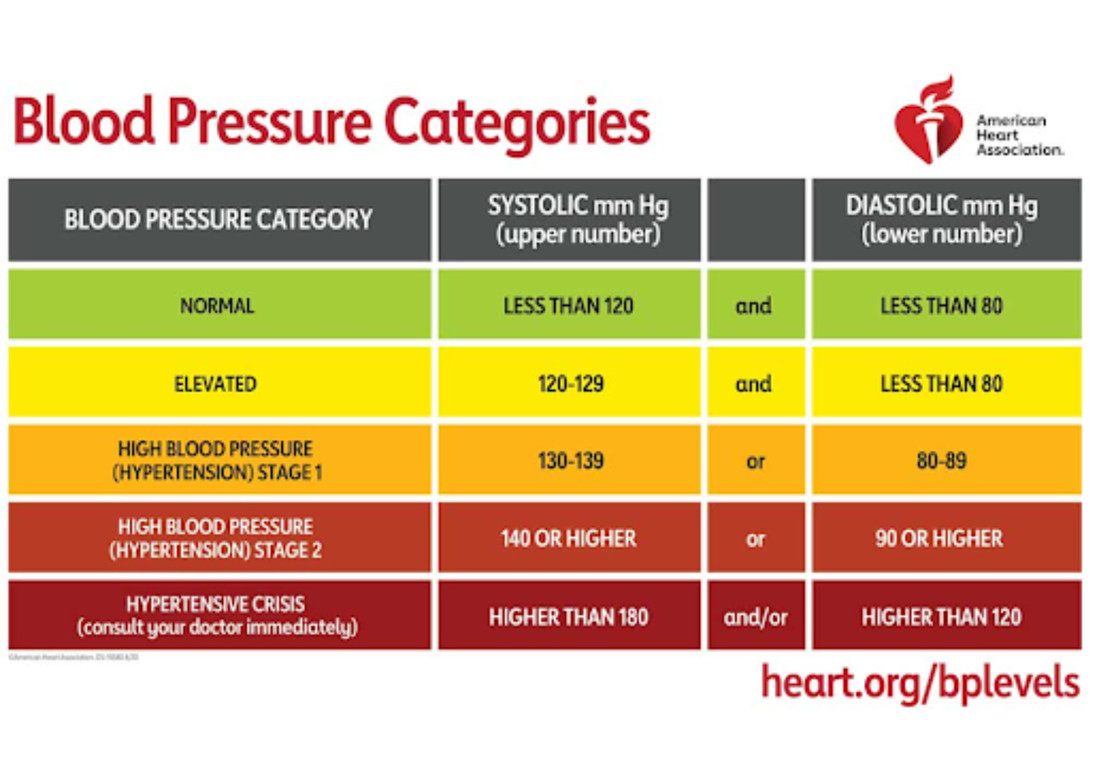
What is the big fuss about blood pressure? Even bigger than that, what is blood pressure and why is it important to check and monitor? What’s the correct way to check blood pressure? These are all very important questions. Let’s explore this further!
From the American Heart Association, blood pressure is defined as the result of two forces. The first force (systolic pressure) happens as blood pumps out of the heart and into the arteries. The second force (diastolic pressure) is created as the heart rests between heart beats. These two forces are each represented by numbers in a blood pressure reading. This force created by your beating heart is what is responsible for sending blood through your body to tissues and organs.
The new guidelines define normal blood pressure as readings of a systolic blood pressure under 120mmHg and a diastolic blood pressure under 80mmHg. The chart above categorizes the levels of blood pressure as they become higher than the recommended normal.
Why should you care about high blood pressure?
When blood pressure is high for too long, it can damage the walls of blood vessels, causing them to develop tiny tears. To fix these damaged areas, the body sends special cells that stick to the site. Over time, substances such as cholesterol and fats may also build up at these damaged spots, forming plaque(atherosclerosis). The heart can also become enlarged from pumping against higher forces. This can result in congestive heart failure. High blood pressure also transmits blood to our organs at a higher pressure, causing organ damage such as kidney failure, strokes, and eye damage.
Check out this awesome video from the AHA explaining high blood pressure in further detail!
Are you checking your blood pressure the right way?
Steps for appropriately checking your blood pressure:
- 30 minutes prior to checking your blood pressure, make sure you do not smoke, exercise, drink caffeinated beverages or alcohol
- Rest for at least 5 minutes. Try to relax, don’t talk, rest your arm on a comfortable surface at the level of your heart, sit upright and keep feet on the floor. It is really important that your arm is well supported. If you are holding your arm in the air, this will make your blood pressure reading falsely elevated.
- If at all possible, use a validated upper arm(brachial) cuff recommended by the AHA
- Align the artery arrow with the center of the fold at your elbow, making sure the cuff is appropriately tightened around the upper arm
- AHA recommends taking 2 blood pressure readings, at least 1 minute apart, in the morning before you take your medications if you have any, then again in the evening twice, 1 minute apart.
- Record these readings and bring them to your medical professional for review.Check out this graphic for a picture of an appropriately taken blood pressure.
Here is the list of validated blood pressure cuffs recommended by the AHA. It is important to use an appropriately sized cuff with the appropriate technique with the appropriate device to get the most accurate, reproducible readings at home to take to your medical professional!
Is there a difference between my wrist cuff and an upper arm cuff?
I thought you would never ask. There most definitely is. The gold standard outside of taking blood pressures with a catheter inside the actual artery(done in controlled medical settings) is to use a validated upper arm(brachial) cuff. In an article published in the AHA journal of Hypertension in 2019, in a study of 303 participants, only 43% of the participants had a blood pressure within 5mmHg between the radial and the brachial blood pressure readings. 57% of the participants had greater than 5mmHg between the two readings and 14% had a greater than 15mmHg difference! That would make a huge difference in blood pressure management, medication escalation or deescalation, etc. It is most common for the wrist cuffs(radial artery reading) to be higher than the upper arm readings. This is largely because as we age and our arteries are affected by stress, inflammation, etc they start to harden and often harden furthest away from the heart first. This difference in the blood pressures is often called the Popeye phenomena, playing on his large forearms.
At Back in Line, we can help monitor your blood pressures. Using our Cardiex XCel, we can not only standardize brachial blood pressure readings but take it a step further and test your central blood pressures. This is a reading of the blood pressure coming directly from the heart, hitting our organs first. We can use these peripheral and central blood pressure readings to accurately follow medications which are newly introduced or for individuals who may want to try and get off their blood pressure medications. Here’s to health blood pressures!



